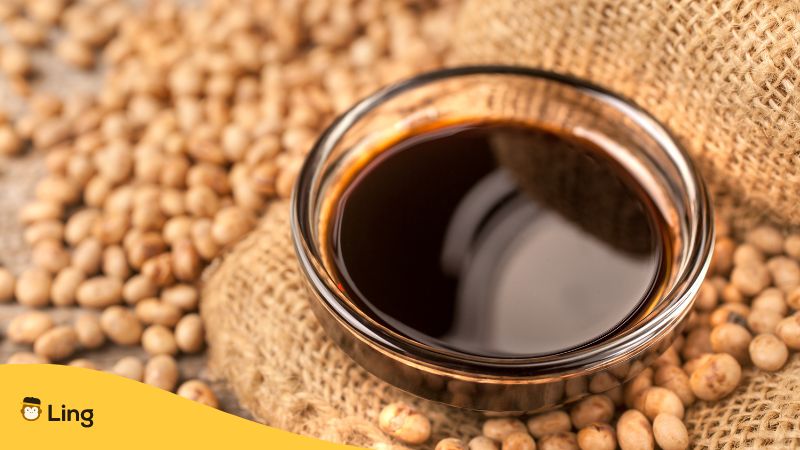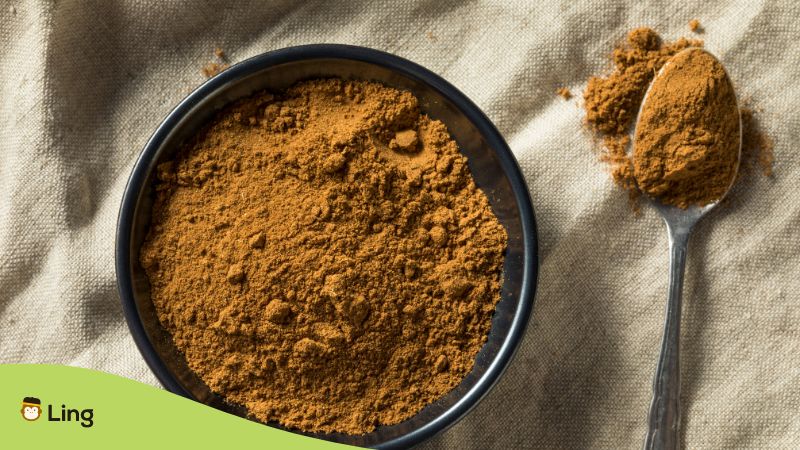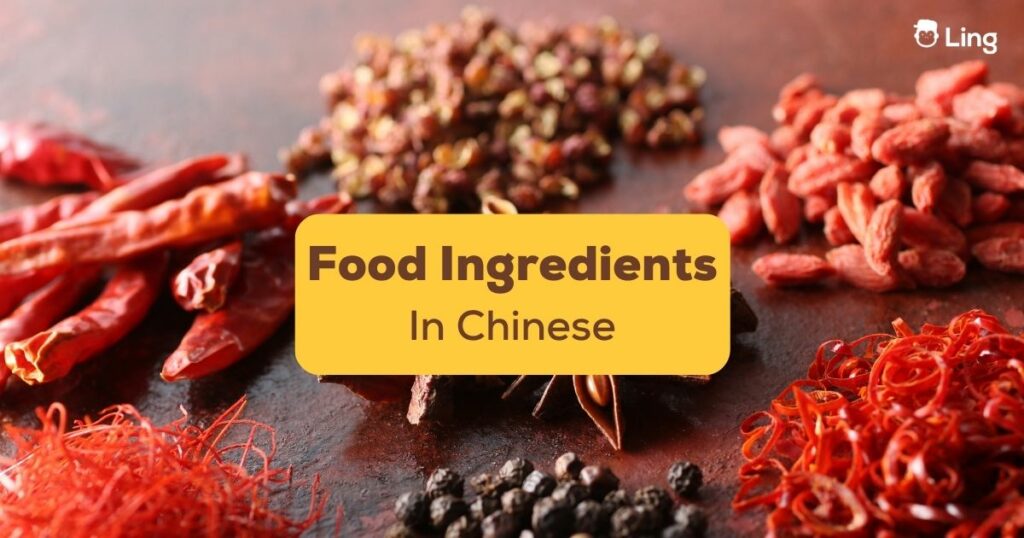Chinese food is delicious and so much fun to eat. It’s also a great way to learn Chinese, especially if you’re learning Chinese through immersion.
But if you want to really dive into the world of Chinese cuisine, it’s important to learn some terms in Chinese food ingredients vocabulary.
After all, how can you enjoy a meal if you don’t know what’s in it?
We’ve put together this list of 5 essentials for those who want to get more out of their next Chinese-food experience:
Ingredients In Chinese
1. Scallions, Ginger, Garlic – 葱姜蒜 (Cōng Jiāng Suàn)
Scallion, ginger, and garlic are the “big three” aromatics in Chinese cuisine, and they are commonly mentioned in recipes as 葱姜蒜 (cōng jiāng suàn).
Scallions 葱 (cōng) are sometimes called green onions or spring onions in English. They have long white roots with green leaves that look like thin stalks.
Ginger 薑 (jiāng) is a spice used widely in most dishes on the Chinese menu. It has a very fragrant, spicy flavor that adds depth to dishes.
Garlic 蒜 (suàn) has a strong, pungent flavor that adds authenticity to most Chinese dishes. It’s often cooked slowly with meats or seafood to infuse them with flavor.
These three elements together form the trinity of Chinese cooking. Not only do they provide a unique flavor to every meal, but they also offer components that are good for health.
2. Soy Sauce – 酱油 (Jiàng Yóu)
Soy sauce is one of the primary ingredients in many Chinese dishes. Hence, it’s a must-have in your Chinese food vocabulary. It’s used to season everything from fried rice to dumplings—and it can also be used as a dipping sauce for spring rolls or egg rolls.
Soy sauce is a thick, dark brown liquid made from fermented soybeans and wheat. The liquid is then aged and then combined with salt and water, which gives it its distinctive flavor and taste.
The Chinese have a deep appreciation for soy sauce. So, they’ve made a lot of different kinds set of uses.
The three most common types of soy sauce in traditional Chinese cookery are:
- Light soy sauce – 生抽 (shēng chōu)
- Dark soy sauce – 老抽 (lǎo chōu)
- Normal soy sauce – 酱油 (jiàng yóu)
The difference between these three types of soy sauce is their saltiness and color.

3. White Pepper Powder – 白胡椒粉 (Bái Hú Jiāo Fěn)
White pepper powder 白胡椒粉 (bái hú jiāo fěn) is used in Chinese food in the same way that black pepper is used in Western cuisine.
It’s an essential spice to have on hand, but it’s not something you’ll find in every kitchen pantry.
The best use of this pepper is in hot and sour soup, 酸辣汤 (suān là tāng). The spice is also used in marinades, stir-fries, and other meat dishes.
4. Oyster Sauce – 蚝油 (Hào Yóu)
Oyster sauce is a key ingredient in Chinese recipes. It is a thick sauce made from oysters and other ingredients, and it has a strong umami flavor that adds depth to any dish it’s added to. Like the white pepper powder, this sauce is best in stir-fries, marinades, and other meat dishes.
Fun fact: There are different quality levels of oyster sauce. The premium quality has a more robust flavor because of its higher concentration of oyster essence. On the other hand, there is more sugar in the normal one, and it’s cheaper.
5. Shaoxing Wine – 绍兴酒 (Shào Xīng Jiǔ)
Shaoxing wine 绍兴酒 (shào xīng jiǔ) is one of the ideal Chinese ingredients. It’s used to flavor soups, braises, and sauces, as well as to tenderize meat.
If you’ve ever had a dish with a “yellow” sauce, it was probably made with Shaoxing wine!
The wine is named after the city of Shaoxing in eastern China, where it’s produced. It can be made from either rice or wheat—the same way that other wines are made from grapes.
6. Hoisin Sauce – 海鲜酱 (Hǎi Xiān Jiàng)
Hoisin sauce is a sweet and savory Chinese sauce made from soybeans and sugar. It’s generally used as a marinade for meats, but it also makes a great dipping sauce!
Hoisin sauce can be found in most grocery stores. If you don’t have any on hand, you can make your own using these ingredients:
- 1/2 cup of soy sauce – 酱油 (jiàng yóu)
- 1/4 cup of rice vinegar – 米醋 (mǐ cù)
- 2 teaspoons of brown sugar – 黄糖 (huángtáng)
- 1 teaspoon of sesame oil – 芝麻油 (zhīma yóu)
7. Five Spice Powder – 五香粉 (Wǔ Xiāng Fěn)
This blend of spices includes cinnamon, cloves, fennel seeds, Sichuan peppercorn, and star anise. It has a warm, spicy taste that’s great for adding to marinades and sauces. You can find five spice powders at most Asian grocery stores.

8. Soybean Paste – 豆瓣酱 (Dòu Bàn Jiàng)
Dòu bàn jiàng is a salty, fermented-savory, and spicy thick brown paste. If you want to make authentic Sichuan dishes like Mapo Tofu, you’ll need to get this essential ingredient. If you like spicy foods, you should definitely give this item a try. It instantly elevates the taste of even the most basic food.
9. Peanut Oil – 花生油 (Huā Shēng Yóu)
Peanut oil is an ingredient in the Chinese kitchen that adds flavor and texture to dishes. It has a high smoke point, so it’s excellent for frying or sautéing.
It has a strong flavor and aroma, so you don’t have to use a ton to get the effect you’re looking for.
10. Chinkiang Vinegar – 镇江香醋 (Zhèn Jiāng Xiāng Cù)
Almost as black in hue as soy sauce, Chinkiang vinegar stands out immediately. Flavor-wise, it’s bolder and tangier than the lighter rice vinegar, with a malty smell and a woodsy character. As balsamic vinegar is to Italian cooking, Chinkiang vinegar is to Chinese.

Chinese Ingredients Vocabulary Related To Meats And Seafood
Here are some of the most common Chinese words related to meats and seafood:
Chinese Ingredients Vocabulary Related To Herbs And Spices
Below is a list of some ordinary Chinese words related to herbs and spices:
Know Your Chinese Ingredients Essentials
Chinese food is among the most popular cuisines in the world, and it’s no wonder why. It’s delicious, filling, and has a whole lot of variety!
But if you want to get into it—and who doesn’t?—you’ll need to learn some new words. Luckily, it doesn’t have to be complicated or intimidating.
With these ten essentials for Chinese food ingredients, you’ll be well on your way to being able to talk about Chinese cuisine like a pro.
Want to learn more Chinese vocabulary? Check out the Ling app now!

Learn Chinese With The Ling App
Ling is the app for you if you’re looking for the perfect opportunity to learn Chinese. It’s fun and easy to use and gives you the tools you need to master the language.
With more than 2000 lessons and fun quizzes, Ling gives you the resources to learn Chinese.
The app is designed for beginners and intermediate learners, so it’s perfect for anyone who wants to learn a new language.
So what are you waiting for?
Download the app from the App Store or Play Store, and then get started now!






















